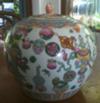Commenting is deactivated.
Please post all new topics and queries to the
Discussion Forum
Qianlong Ginger Jar
by Chris
(Brisbane, Queensland, Australia)

I purchased this item at the state owned Shanghai Arts and Crafts centre in 1988 for several hundred dollars. They had a small "special" area for "antiques". I had confidence at the time as I was doing business with that department in the area of repro furniture so was accompanied by a delegation. The piece had export approval and came with appropriate documentation that had to be inspected at departure by China Customs (rice paper docs now lost). The wax seal on the bottom was part of the process. I may have been the victim of a convincing scam. What do you think?
Comments for Qianlong Ginger Jar
|
||
|
||
|
||
|
||
search by keyword







